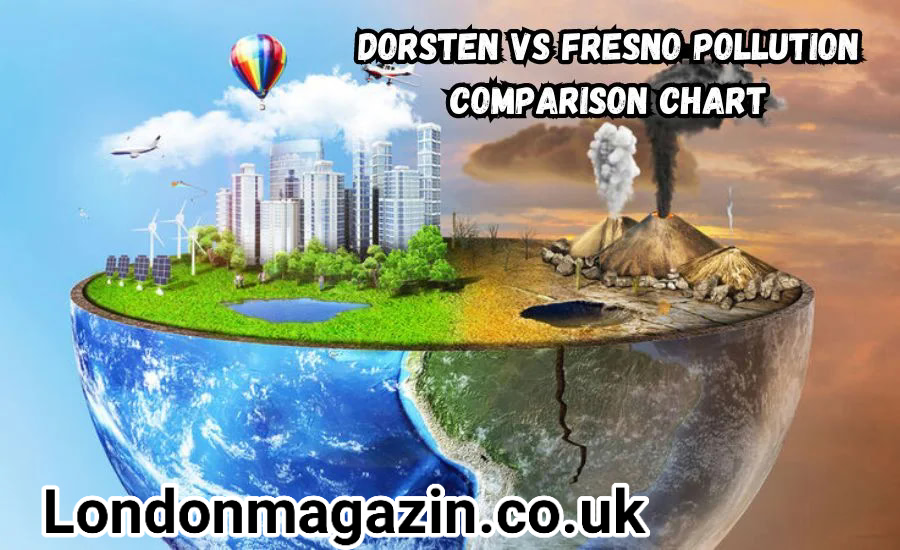Pollution has become a pressing global issue, affecting urban and rural areas alike. Whether it’s the polluted air of large metropolitan cities or the industrial emissions of smaller towns, air quality is a major concern for residents and policymakers. Among the numerous cities around the world facing pollution challenges, Dorsten, a city in Germany, and Fresno, a city in California, USA, provide an interesting comparison. Both cities experience pollution, but the sources, types, and severity vary significantly.
This article aims to explore the pollution levels in Dorsten and Fresno, comparing their environmental challenges, health impacts, government responses, and ongoing efforts to combat pollution. We will also examine available data and trends, offering insights into the potential causes and solutions for pollution in these two cities.
Pollution in Dorsten: A Snapshot
Dorsten, located in the North Rhine-Westphalia region of Germany, is part of the Ruhr industrial area—one of Europe’s largest industrial regions. Historically, this area has been known for its coal mining, steel production, and other heavy industries. These industries have long been a significant source of air, water, and soil pollution.
Over the years, Germany has made significant strides in improving its environmental policies and reducing pollution levels. However, Dorsten still experiences challenges related to air quality due to its industrial heritage. The city’s air quality is impacted by vehicle emissions, industrial activities, and the ongoing use of fossil fuels for energy.
- Air Pollution in Dorsten: The major pollutants in Dorsten are particulate matter (PM10 and PM2.5), nitrogen dioxide (NO2), and sulfur dioxide (SO2). These pollutants primarily come from traffic, industrial emissions, and heating systems. While the air quality has improved in recent years, there are still periods, especially during winter, when pollution levels exceed recommended limits.
A key factor contributing to air pollution in Dorsten is the geographical location. The region is surrounded by dense urban areas and industrial zones, creating a “pollution trap” where emissions from various sources accumulate. This situation is exacerbated by the weather patterns, which can limit the dispersion of pollutants.
- Water and Soil Pollution: Industrial activities have also impacted water quality in Dorsten, with some areas seeing contamination from chemicals used in manufacturing processes. The Ruhr River, which flows through the region, has historically been polluted by runoff from factories and untreated sewage. However, the city has made efforts to clean up the water and manage waste better.

Pollution in Fresno: A Snapshot
Fresno, located in California’s Central Valley, is a city that has long struggled with pollution due to a variety of factors, including rapid urbanization, agriculture, and traffic. Fresno’s air quality is often rated among the worst in the United States, largely due to the city’s geographical location and the emissions from vehicles and agriculture.
- Air Pollution in Fresno: Fresno faces some of the highest levels of ozone pollution in the United States. The Central Valley, where Fresno is situated, is a large bowl-like valley surrounded by mountains. This geographic feature contributes to the trapping of pollutants, dorsten vs fresno pollution comparison especially during the hot summer months when ozone levels peak. PM2.5 (fine particulate matter) is another major air pollutant, coming primarily from agricultural burning, vehicle emissions, and industrial activities.
The city also suffers from high levels of carbon monoxide (CO) and nitrogen oxides (NOx), both of which result from traffic congestion, especially in urban areas.
- Water and Soil Pollution: Fresno’s agricultural industry has been linked to water pollution due to the heavy use of pesticides, herbicides, and fertilizers. These chemicals often end up in nearby rivers and groundwater, contaminating drinking water supplies and harming aquatic ecosystems. Additionally, the Central Valley’s reliance on irrigation for farming has contributed to soil degradation and the accumulation of salts and other harmful substances in the soil.
Comparing Dorsten and Fresno Pollution Levels
While both Dorsten and Fresno face significant pollution challenges, the nature and extent of their pollution problems are quite different.
- Air Pollution: In terms of air pollution, Fresno tends to have more severe issues due to its geographical setting in a valley and the high volume of dorsten vs fresno pollution comparison emissions from both agriculture and traffic. The region’s warm climate exacerbates ozone pollution, which can significantly affect residents’ health. In contrast, while Dorsten does experience high levels of particulate matter and nitrogen dioxide, the air quality issues here are not as extreme as in Fresno.
- Health Impacts: Both cities suffer from the health impacts of pollution, particularly respiratory conditions like asthma, bronchitis, and other lung diseases. Studies have shown that in Fresno, people are more likely to experience severe asthma and other respiratory problems due to the combination of high ozone levels and fine particulate matter. In Dorsten, while the health impacts are also serious, the German healthcare system’s focus on environmental health and pollution regulation has helped mitigate some of the risks.
- Government Responses: Germany has a strong track record when it comes to environmental protection, with strict air quality regulations and policies aimed at reducing industrial emissions. Dorsten benefits from the country’s broader efforts to reduce carbon emissions and improve air quality through sustainable energy use and eco-friendly urban planning.
Fresno, on the other hand, is still struggling with pollution despite state and federal efforts to address the problem. While California has dorsten vs fresno pollution comparison some of the toughest environmental laws in the U.S., Fresno’s air quality remains a significant challenge, partly due to the high volume of traffic, the use of pesticides, and the lack of comprehensive solutions to tackle agricultural emissions.
- Water Quality: Water pollution in both cities is influenced by industrial and agricultural activities. While Dorsten has made considerable progress in improving water quality, Fresno’s water continues to be impacted by agricultural runoff and the overuse of chemicals in farming. However, efforts to manage water resources in both cities have been put in place, with more focus on protecting drinking water supplies and restoring ecosystems.

Conclusion
The pollution challenges faced by Dorsten and Fresno are both complex and varied. Dorsten, with its industrial history, faces significant air quality issues, particularly with particulate matter and nitrogen oxides. However, the city benefits from Germany’s strong environmental policies, which have led to improvements in air and water quality over the years.
Fresno, located in the heart of California’s agricultural region, faces perhaps more severe pollution challenges, particularly in terms of ozone and fine particulate matter. The region’s geographical features exacerbate air pollution, and the heavy use of dorsten vs fresno pollution comparison chart chemicals in farming has contributed to water and soil pollution. While California’s environmental laws are among the strictest in the U.S., addressing pollution in Fresno remains a difficult task due to the city’s rapid growth and reliance on agriculture.
In both cities, the health impacts of pollution are significant, affecting respiratory health and overall quality of life for residents. However, ongoing efforts from local and national governments in both Germany and the U.S. are focused on improving air and water quality, with varying levels of success.
Also read this; rice-purity-test
FAQs About Dorsten vs Fresno Pollution Comparison
- What are the main causes of pollution in Dorsten? The primary causes of pollution in Dorsten are industrial emissions, vehicle traffic, and heating systems that rely on fossil fuels. The city’s location in the Ruhr industrial region also contributes to pollution from factories and energy production.
- Why is air pollution so severe in Fresno? Fresno’s air pollution is mainly caused by high levels of ozone and particulate matter. These pollutants are primarily the result of vehicle emissions, agricultural burning, and industrial activities. The city’s geographic location in a valley traps pollutants, making air quality particularly poor during the summer months.
- How does water pollution in Dorsten compare to Fresno? Both cities experience water pollution, but the causes differ. In Dorsten, industrial runoff and sewage have historically contaminated the Ruhr River, but the situation has improved in recent years. In Fresno, agricultural runoff, including pesticides and fertilizers, is the main cause of water pollution.
- What are the health impacts of pollution in both cities? In both cities, air pollution leads to respiratory issues such as asthma and bronchitis. Fresno residents, however, may experience more severe respiratory problems due to higher levels of ozone and fine particulate matter. In Dorsten, pollution-related health problems are similar but somewhat mitigated by stricter environmental regulations.
- What measures are being taken to reduce pollution in Dorsten and Fresno? Dorsten benefits from Germany’s strict environmental laws, which focus on reducing industrial emissions, transitioning to renewable energy, and improving air quality. Fresno, while it has some of the toughest environmental laws in the U.S., faces challenges due to the region’s dependence on agriculture. Measures include reducing vehicle emissions, regulating agricultural practices, and promoting clean energy alternatives.


